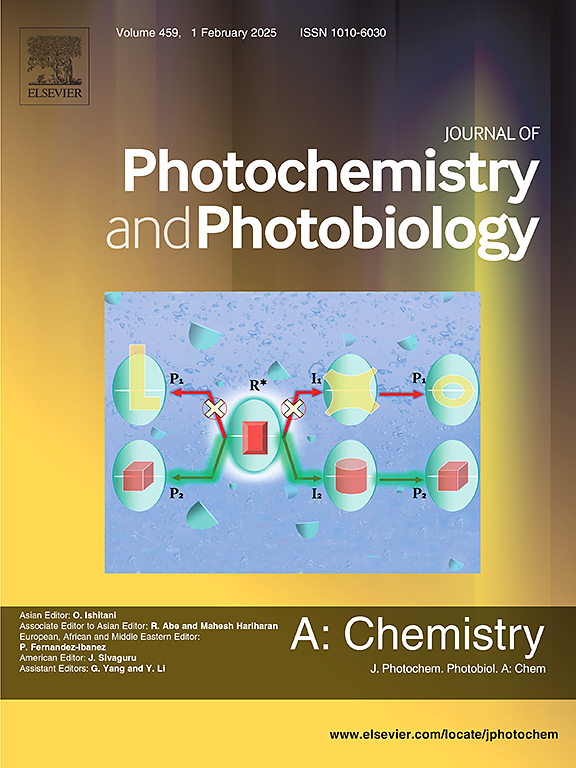Green validation of synchronous fluorometry study applied on binary mixture (risperidone and biperiden hydrochloride as a co-administered drugs) used for treatment of schizophrenia
IF 4.7
3区 化学
Q2 CHEMISTRY, PHYSICAL
Journal of Photochemistry and Photobiology A-chemistry
Pub Date : 2025-06-03
DOI:10.1016/j.jphotochem.2025.116536
引用次数: 0
Abstract
Risperidone and biperiden hydrochloride concentration levels have been successfully quantified in laboratory prepared mixture, tablets for each studied drug and spiked human plasma through an innovative spectrofluorimetric approach. In order to successfully estimate risperidone at 302 nm and biperiden hydrochloride at 405 nm in the presence of each other at Δλ of 60 nm, the spectrofluorometric technique’s selectivity is increased by combining both derivative and synchronous spectrofluorometric approaches. The technique was extensively validated by following the validation requirements of the International Conference on Harmonization, and linearity was achieved for the two medicines across the range of 20–200 ng mL−1. The technique was successfully used to commercial tablets, combination made in the lab and spiked human plasma. The results showed good agreement with the approaches that have been published. The measurement of risperidone and biperiden hydrochloride in spiked human plasma samples was relevant. The quantitation limits were 11.626 and 11.522 ngmL−1 and the detection limits were 3.873 and 5.023 ng ml−1 for risperidone and biperiden hydrochloride, respectively. A statistical comparison of the results with other published analytical techniques revealed no significant difference. The validation of the procedure was successfully completed in compliance with ICH guidelines. The suggested approach included an environmentally beneficial element by using water as the ideal diluting solvent.

同步荧光法研究应用于治疗精神分裂症的二元混合物(利培酮和盐酸双培脲共同给药)的绿色验证
利培酮和盐酸双培脲的浓度水平已通过创新的荧光光谱法成功地定量实验室配制的混合物、所研究药物的片剂和加标的人血浆。为了成功地估计利培酮在302 nm和盐酸双哌啶在405 nm,在彼此存在的情况下在Δλ (60 nm),通过结合导数和同步荧光光谱法提高了荧光光谱技术的选择性。该技术通过遵循国际协调会议的验证要求进行了广泛的验证,并在20-200 ng mL−1范围内实现了两种药物的线性。该技术已成功应用于商业片剂、实验室合成的复方制剂和人血浆中。结果与已发表的方法一致。加标后的人血浆样品中利培酮和盐酸双培脲的含量测定具有相关性。利培酮和盐酸双培酮的定量限分别为11.626和11.522 ng ml−1,检出限分别为3.873和5.023 ng ml−1。结果与其他已发表的分析技术的统计比较显示没有显著差异。该方法的验证已按照ICH指南成功完成。建议的方法包括使用水作为理想稀释溶剂的环境有益元素。
本文章由计算机程序翻译,如有差异,请以英文原文为准。
求助全文
约1分钟内获得全文
求助全文
来源期刊
CiteScore
7.90
自引率
7.00%
发文量
580
审稿时长
48 days
期刊介绍:
JPPA publishes the results of fundamental studies on all aspects of chemical phenomena induced by interactions between light and molecules/matter of all kinds.
All systems capable of being described at the molecular or integrated multimolecular level are appropriate for the journal. This includes all molecular chemical species as well as biomolecular, supramolecular, polymer and other macromolecular systems, as well as solid state photochemistry. In addition, the journal publishes studies of semiconductor and other photoactive organic and inorganic materials, photocatalysis (organic, inorganic, supramolecular and superconductor).
The scope includes condensed and gas phase photochemistry, as well as synchrotron radiation chemistry. A broad range of processes and techniques in photochemistry are covered such as light induced energy, electron and proton transfer; nonlinear photochemical behavior; mechanistic investigation of photochemical reactions and identification of the products of photochemical reactions; quantum yield determinations and measurements of rate constants for primary and secondary photochemical processes; steady-state and time-resolved emission, ultrafast spectroscopic methods, single molecule spectroscopy, time resolved X-ray diffraction, luminescence microscopy, and scattering spectroscopy applied to photochemistry. Papers in emerging and applied areas such as luminescent sensors, electroluminescence, solar energy conversion, atmospheric photochemistry, environmental remediation, and related photocatalytic chemistry are also welcome.

 求助内容:
求助内容: 应助结果提醒方式:
应助结果提醒方式:


